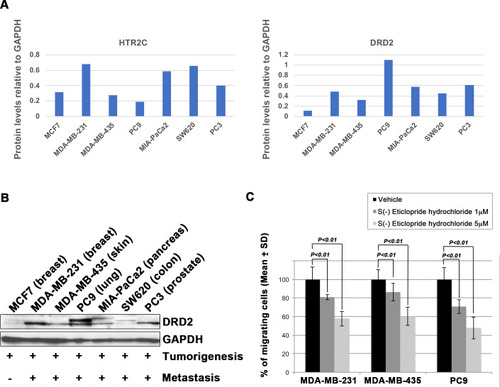Fig. 2 Supplemental 1
- ID
- ZDB-FIG-240801-13
- Publication
- Nakayama et al., 2021 - A zebrafish embryo screen utilizing gastrulation identifies the HTR2C inhibitor pizotifen as a suppressor of EMT-mediated metastasis
- Other Figures
- All Figure Page
- Back to All Figure Page
|
Blocking Dopamine receptor D2 with S(-) Eticlopride hydrochloride suppressed cell motility and invasion of highly metastatic human cancer cells in a dose-dependent manner. (A) Quantification analyses of western blotting bands in Figure 2B. The analyses were performed by ImageJ. Signal strength of bands of HTR2C (left) and DRD2 (right) was normalized by that of GAPDH. (B) Western blot analysis of DRD2 levels in non-metastatic human cancer cell line, MCF7 (breast) and highly metastatic human cancer cell lines, MDA-MB-231 (breast), MDA-MB-435 (melanoma), MIA-PaCa2 (pancreas), PC3 (prostate), and SW620 (colon); GAPDH loading control is shown (bottom). GAPDH control was obtained in the same experiment from Figure 2B. (C) Effect of S(-)eticlopride hydrochloride on cell motility and invasion of MBA-MB-231, MDA-MB-435, and PC9 cells. Either vehicle- or pizotifen-treated cells were subjected to Boyden chamber assays. Fetal bovine serum (1% v/v) was used as the chemoattractant in both assays. Each experiment was performed at least twice. Statistical analysis was determined by Student’s t test. |

